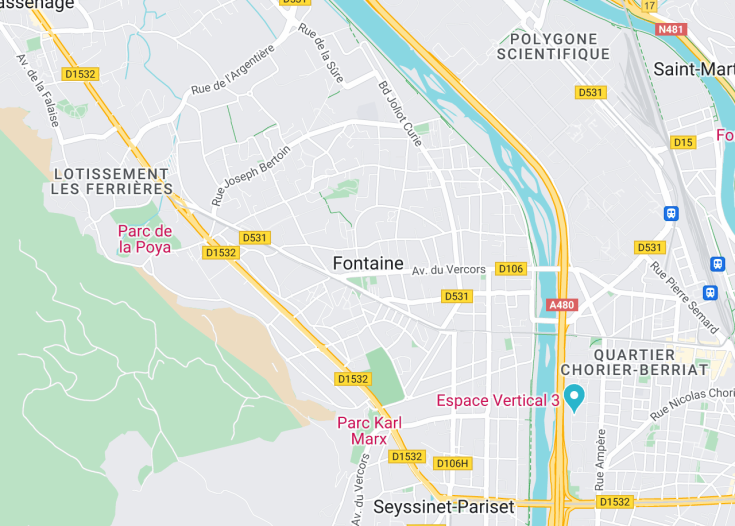Fontaine in France, located at the foot of the Vercors mountain range, epitomizes charm and historical richness. Celebrated for its proximity to Grenoble and its pristine natural surroundings, this vibrant community offers a unique blend of cultural heritage and outdoor recreation opportunities, making it an ideal destination for both history enthusiasts and nature lovers.
When visiting Fontaine, take time to explore the Parc de la Poya. This green haven is perfect for family picnics and leisurely walks amidst lush landscapes.
Plan your visit for late spring or early summer to enjoy Fontaine’s natural settings in full bloom, enhancing your scenic walks or cycling tours.
Fontaine: A Gem in the French Alps
| Country | France |
| Time in Fontaine | GMT+1 |
| Language spoken | French |
| Population | 22,000 (source: latest urban statistic) |
| Currency | Euro (€, EUR) |
| Airports |
|
Located in southeast France, Fontaine is a picturesque town nestled in the French Alps. Known for its scenic beauty and proximity to the natural parks of the Vercors Range, this tranquil settlement offers a unique blend of cultural heritage and outdoor adventures. Fontaine boasts a rich history that dates back to the Roman era, evident in its architecture and local museums.
Where is Fontaine?
Fontaine is situated close to Grenoble in the Isère department, reflecting the charm of the Alpine region.
Distances:
| Route | Distance by car | Time by car |
| Grenoble to Fontaine | 2.5 miles (4 km) | 10 minutes |
| Lyon to Fontaine | 67 miles (108 km) | 1 hour 15 minutes |
| Paris to Fontaine | 355 miles (571 km) | 5 hours 30 minutes |
What is Fontaine famous for?
Fontaine is celebrated for its proximity to the Vercors National Park, offering ample opportunities for hiking, cycling, and skiing, making it a haven for outdoor enthusiasts.
History
Prehistoric to Medieval Times
Fontaine, situated in the picturesque region of France, traces its origins back to prehistoric times when early settlers were attracted by its fertile lands and strategic location near vital water sources. Archaeological findings suggest that Fontaine was inhabited by Celtic tribes, followed by Roman occupation, evident from ruins and artifacts found in the area. The town’s name, derived from numerous natural springs (‘fontaines’ in French), highlights its historical connection with water.
Medieval Period to 18th Century
The Middle Ages saw Fontaine become a focal point due to its position on several trade routes across France. By the 12th century, a fortress was established, serving both as a military base and a residence for local nobility. During the Renaissance, Fontaine experienced cultural flourishing, with the construction of a church and several public buildings that exhibited Gothic architectural influences. The town was also impacted during the religious wars in France but managed to preserve much of its heritage and architecture.
19th Century to Present Day
The industrial revolution brought significant changes to Fontaine, with developments in local industries such as textiles and metallurgy. The 20th century was marked by war and reconstruction, particularly after World War II when much of the town had to be rebuilt. In recent decades, Fontaine has transformed into a cultural and tourist hub, known for its historical sites and vibrant cultural scene. Preservation of its historic core alongside modern amenities makes Fontaine a unique blend of the old and the new.
Visit Fontaine
What to see and do in Fontaine
Fontaine, France is a treasure trove of historical and cultural attractions. Key highlights include:
- The ancient fortress, which offers panoramic views of the surrounding countryside and insights into the region’s medieval past.
- The Gothic church, renowned for its intricate architecture and stained glass windows.
- Several museums that detail the local history, from prehistoric times to the modern era.
- Walking tours around the town’s old quarter, allowing visitors to soak in the charming streetscapes and historic buildings.
Besides historical sites, Fontaine also hosts various workshops and art exhibitions, showcasing local craftsmanship and contemporary art.
Festivals and Cultural Events in Fontaine
Fontaine is vibrant with cultural festivities throughout the year. Highlights include the Fontaine Spring Festival in April, celebrating the town’s heritage and the arrival of spring with music, dance, and local cuisine. The Summer Arts Festival in July features international artists and performers, making it a must-visit for art lovers. Additionally, the Autumn Harvest Fair in October offers a taste of local agricultural products and traditional crafts.
Best time to visit Fontaine
The best time to visit Fontaine is during the spring and summer months. From April to July, the weather is pleasantly warm, and the town’s cultural calendar is packed with events and activities. This period offers an ideal blend of good weather and vibrant local culture, perfect for exploring outdoor attractions and participating in festivals.
Is Fontaine worth visiting?
Fontaine offers a compelling blend of historical depth, cultural richness, and scenic beauty, making it a noteworthy destination in France. Visitors can explore well-preserved medieval architecture, participate in lively cultural festivals, and enjoy local cuisine. However, it’s worth noting that the town might not cater as well to those seeking modern entertainment or shopping experiences. Nonetheless, for those interested in history and culture, Fontaine promises a rewarding visit. The limited nightlife and relatively quiet atmosphere might be less appealing for some, but they contribute to the town’s tranquil charm.









